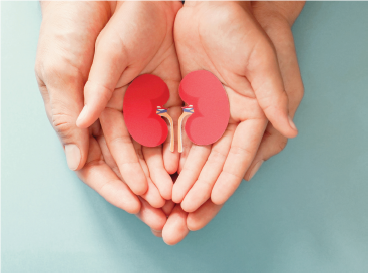
As the number of “living donors” increases, technology is streamlining the process—and saving lives.
About 1,500 patients with end-stage kidney disease are on the waiting list for a kidney transplant at the Renal and Pancreas Transplant Division at Cooperman Barnabas Medical Center (CBMC). Nationwide, the number of patients on kidney transplant waiting lists is around 100,000. The average wait time is three to five years.
It’s a challenging time for patients in need, but there’s one bright spot: an increase in the number of living donor kidney transplants, in which healthy people donate one of their kidneys, either to a loved one or to a stranger.
As awareness of living kidney donation rises, so does the number of inquiries about it. Now the Living Donor Institute (LDI) at CBMC—the only organization of its kind in New Jersey— has implemented an innovative program, known as BREEZE TRANSPLANT, an online questionnaire that immediately moves the process forward for interested potential donors.
An Efficient Approach
“We receive more than 100 donor referrals each month, and we don’t want people to have to wait for answers,” explains Katie Szucs, MSN, APN-C, CCTC, Clinical Manager of the LDI.
Based on demographic information and other algorithms, the BREEZE program will create a customized questionnaire for a potential donor. Once it’s filled out, the living donor team can review the questionnaire and develop a plan for each potential donor.
“For example, if the person seems to be a good candidate, we can ask them if they’d like to schedule a discussion with our team to learn more, or set up an evaluation,” Szucs explains. “If we’re already in the process of working with a donor for the patient they wish to donate to, we let them know that they are a backup donor and will be contacted if the current donor cannot proceed.
“And if for some reason they aren’t qualified to be a donor, we can tell them why—for example, they may need to lose a certain amount of weight—or empower them to help find other potential donors.”
Filling out a questionnaire carries no commitment and it’s kept confidential, Szucs emphasizes. “Completing a living donor questionnaire enables the living donor team to contact the person and provide more information about the living donation process. If the person is interested in proceeding, we can guide the potential donor through the evaluation. We make sure that the donation is the right thing, medically and psychosocially, for everybody involved.”
TOP 4 REASONS TO DONATE A KIDNEY
- The recipient has an enhanced quality of life after receiving a live donor kidney transplant.
- A live donor kidney can last about twice as long, on average, as a deceased donor kidney.
- A willing donor receives tremendous emotional benefit by fulfilling their wish to donate.
- The gift of a live donor kidney allows the recipient to come off the transplant waiting list, thereby allowing someone else to receive a deceased donor kidney.
Learn more about the Renal and Pancreas Transplant program at Cooperman Barnabas Medical Center.